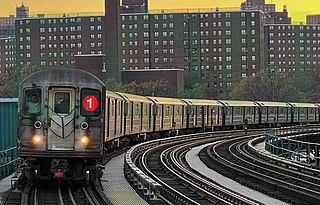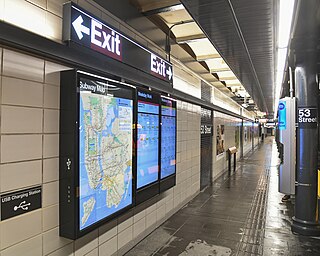
The New York City Subway is a rapid transit system in the New York City boroughs of Manhattan, Brooklyn, Queens, and the Bronx. It is owned by the government of New York City and leased to the New York City Transit Authority, an affiliate agency of the state-run Metropolitan Transportation Authority (MTA). Opened on October 27, 1904, the New York City Subway is one of the world's oldest public transit systems, one of the most-used, and the one with the most stations, with 472 stations in operation.

The 42nd Street Shuttle is a New York City Subway shuttle train service that operates in Manhattan. The shuttle is sometimes referred to as the Grand Central/Times Square Shuttle, since these are the only two stations it serves. The shuttle runs at all times except late nights, with trains running on two tracks underneath 42nd Street between Times Square and Grand Central; for many decades, three tracks had been in service until a major renovation was begun in 2019 reducing it to two tracks. With two stations, it is the shortest regular service in the system by number of stops, running about 2,402 feet (732 m) in 90 seconds as of 2005. The shuttle is used by over 100,000 passengers every day, and by up to 10,200 passengers per hour during rush hours.

The 4 Lexington Avenue Express is a rapid transit service in the A Division of the New York City Subway in New York City, United States. Its route emblem, or "bullet", is colored forest green since it uses the IRT Lexington Avenue Line in Manhattan.

The 3 Seventh Avenue Express is a rapid transit service in the A Division of the New York City Subway. Its route emblem, or "bullet", is colored red since it uses the IRT Broadway–Seventh Avenue Line through most of Manhattan.

The 7 Flushing Local and <7> Flushing Express are two rapid transit services in the A Division of the New York City Subway, providing local and express services along the full length of the IRT Flushing Line. Their route emblems, or "bullets", are colored purple, since they serve the Flushing Line.

The R142A is the second order of new technology cars (NTTs) for the A Division of the New York City Subway. These cars were built by Kawasaki Heavy Industries in the U.S. at Yonkers, New York and Lincoln, Nebraska, and in Japan at Kobe, Hyōgo. They replaced the Redbird trains, including the R26, R28, R29, R33, R33S, and R36. The R142A fleet initially comprised 600 cars, arranged as five-car units.

The R62 is a New York City Subway car model built between 1983 and 1985 by Kawasaki Heavy Industries in Kobe, Japan, for the A Division. A total of 325 cars were built, originally as single units. When the reliability of the fleet improved, they were converted to five-car sets. The cars replaced the remaining R12s, R14s, and R15s, which were all retired by the end of 1984.

The New Lots Avenue station is the eastern terminal of the IRT New Lots Line of the New York City Subway. Located in East New York, Brooklyn, it is the terminal for the 3 train at all times except late nights, when the 4 train takes over service. During rush hours, occasional 2, 4, and 5 trains also stop here.

The F and <F> Queens Boulevard Express/Sixth Avenue Local are two rapid transit services in the B Division of the New York City Subway. Their route bullets are colored orange, since they use and are part of the IND Sixth Avenue Line in Manhattan.

The R68A is a B Division New York City Subway car order consisting of 200 cars built between 1988 and 1989 by Kawasaki Railcar Company in Kobe, Japan, with final assembly done at the Kawasaki plant in Yonkers, New York. A total of 200 cars were built, arranged in four-car sets.

The R62A is a New York City Subway car model built between 1984 and 1987 by Bombardier Transportation for the A Division. The cars were built in La Pocatière, Quebec, with final assembly done in Auburn, New York and Barre, Vermont, under a license from Kawasaki Heavy Industries, manufacturer of the previous R62 order. A total of 825 cars were built, arranged as sets of three, four, or five cars per set. The cars replaced the remaining R17s, R21s, and R22s, which were all retired by early 1988.

Most trains on the New York City Subway are manually operated. As of 2022, the system currently uses automatic block signaling, with fixed wayside signals and automatic train stops. Many portions of the signaling system were installed between the 1930s and 1960s. Because of the age of the subway system, many replacement parts are unavailable from signaling suppliers and must be custom-built for the New York City Transit Authority, which operates the subway. Additionally, some subway lines have reached their train capacity limits and cannot operate extra trains in the current system.

The Gun Hill Road station is a station on the IRT Dyre Avenue Line of the New York City Subway, located at the intersection of Gun Hill Road and Seymour Avenue in the northeast Bronx. It is served by the 5 train at all times.

The Pelham Parkway station is a station on the IRT Dyre Avenue Line of the New York City Subway. Located at the intersection of Pelham Parkway North and the Esplanade in the Bronx, it is served by the 5 train at all times. This station was built as part of the New York, Westchester and Boston Railway (NYW&B), and opened in 1912. This station closed in 1937 with the NYW&B, but reopened in 1941 as a subway station after the portion of the line in the Bronx was purchased by New York City.

The R160 is a class of New Technology Train subway cars built for the New York City Subway's B Division. Entering service between 2006 and 2010, they replaced all R38, R40, and NYCT-operated R44 cars, and most R32 and R42 cars. The R160s are very similar to the earlier R143s and later R179s. The biggest difference between the R160 and R143 is the Flexible Information and Notice Display (FIND) system on the R160s in place of static LED maps on the R143s and all A-Division New Technology fleet.

The R179 is a class of 318 New Technology Train subway cars built by Bombardier Transportation for the New York City Subway's B Division. Entering service between 2017 and 2020, the cars replaced all remaining R32s and R42s.

The R211 is a new technology train (NTT) New York City Subway car being built by Kawasaki Railcar Manufacturing for the B Division and the Staten Island Railway (SIR). They will replace two aging subway car models: all R44 cars on the Staten Island Railway and all R46 subway cars. The order is split into three parts: R211A and R211T cars for the subway and R211S cars for the SIR. The R211Ts employ open gangways between cars, allowing passengers to see and walk through the entire length of the train – a feature not present on the subway's other rolling stock. The base order consists of 535 cars, with options for up to 1,077 additional cars.

New Technology Train (NTT) is the collective term for the modern passenger fleet of the New York City Subway that has entered service since the turn of the 21st century. This includes the current R142, R142A, R143, R160, R179, R188 and R211 models, along with the planned R262 and R268 models. Two prototypes, the R110A and R110B, were used to test the features that would be found on all NTT trains today.

Since the late 20th century, the Metropolitan Transportation Authority has started several projects to maintain and improve the New York City Subway. Some of these projects, such as subway line automation, proposed platform screen doors, the FASTRACK maintenance program, and infrastructural improvements proposed in 2015–2019 Capital Program, contribute toward improving the system's efficiency. Others, such as train-arrival "countdown clocks", "Help Point" station intercoms, "On the Go! Travel Station" passenger kiosks, wireless and cellular network connections in stations, MetroCard fare payment alternatives, and digital ads, are meant to benefit individual passengers. Yet others, including the various methods of subway construction, do not directly impact the passenger interface, but are used to make subway operations efficient.

















